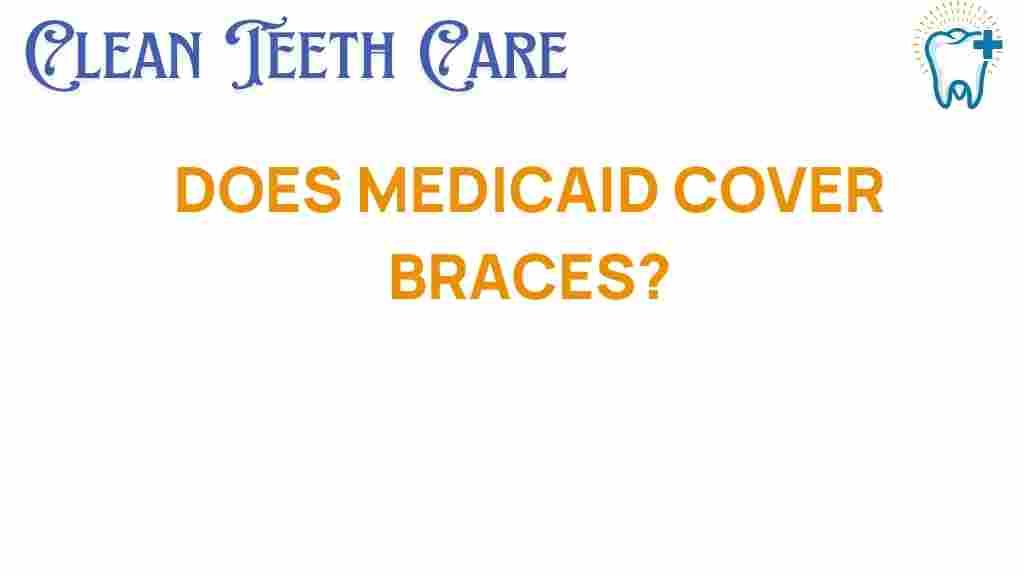Unraveling the Mystery: Does Medicaid Cover Braces for You?
When it comes to oral health and dental care, many families seek assistance with the cost of necessary treatments. One of the most common questions that arise is whether Medicaid covers braces, especially for children. This article will explore Medicaid’s coverage for dental braces, the eligibility criteria, available treatment options, and financial assistance for orthodontic care. Whether you’re looking for information on children’s braces or adult orthodontics, this comprehensive guide will help you understand your options.
Understanding Medicaid and Its Coverage
Medicaid is a government program that provides health insurance to low-income individuals and families. It is jointly funded by the federal and state governments, which means that coverage can vary significantly from one state to another. Generally, Medicaid covers a broad range of health services, but dental coverage often has specific limitations.
In most states, Medicaid offers some level of dental care for children, often referred to as EPSDT (Early and Periodic Screening, Diagnostic, and Treatment) services. Under this provision, Medicaid must cover necessary dental services, including orthodontic treatment, if it is deemed medically necessary.
Eligibility for Medicaid Coverage of Braces
Not all individuals who qualify for Medicaid automatically receive coverage for braces. Here are some factors that determine eligibility:
- Income Level: Medicaid eligibility is primarily income-based. You must meet your state’s income requirements.
- Age: Medicaid typically provides dental coverage for children under the age of 21. Some states extend coverage to adults.
- Medical Necessity: For braces to be covered, they usually must be considered medically necessary. This is often assessed through a dental evaluation.
What Constitutes Medical Necessity for Orthodontics?
Medical necessity for orthodontic treatment, such as braces, varies by state but generally includes:
- Severe malocclusion (misalignment of teeth) that affects oral function.
- Jaw issues that lead to pain or difficulty in chewing and speaking.
- Other significant oral health problems that braces could help alleviate.
It’s essential to have a thorough evaluation by a dentist or orthodontist to determine if your child or you meet these criteria.
Steps to Determine Coverage for Braces
To find out if Medicaid will cover braces for you or your child, follow these steps:
- Check Eligibility: Verify Medicaid eligibility by visiting your state’s Medicaid website or contacting your local Medicaid office.
- Consult a Dentist: Schedule an appointment with a dentist who accepts Medicaid. They can provide a comprehensive evaluation.
- Obtain Documentation: If braces are deemed necessary, ask your dentist for documentation to support the medical necessity claim.
- Contact Medicaid: Reach out to your Medicaid provider for specific coverage details regarding orthodontic services.
- Submit Claims: If approved, ensure that your orthodontist submits the necessary claims to Medicaid for reimbursement.
Types of Orthodontic Treatments Covered by Medicaid
Medicaid generally covers various orthodontic treatments if they are deemed medically necessary. These may include:
- Traditional Metal Braces: The most common type of braces made from metal brackets and wires.
- Ceramic Braces: Similar to metal braces but less visible, using tooth-colored materials.
- Clear Aligners: Such as Invisalign, which may be covered in some states under specific conditions.
It’s vital to check with your specific state’s Medicaid program, as coverage can differ widely.
Financial Assistance Options
For those who do not qualify for Medicaid or whose braces are not covered, several financial assistance options are available:
- Payment Plans: Many orthodontists offer payment plans that allow families to pay for braces in installments.
- Sliding Scale Fees: Some dental practices provide sliding scale fees based on income, making orthodontic care more affordable.
- Non-Profit Organizations: Organizations like the Orthodontic Care Program offer assistance to families in need.
Challenges in Obtaining Coverage
While Medicaid can provide essential assistance for braces, challenges may arise, including:
- State Variability: Each state has different policies regarding orthodontic coverage, which can lead to confusion.
- Documentation Requirements: Obtaining and submitting the necessary documentation can be a complex process.
- Approval Delays: Sometimes, approval for orthodontic treatment can take longer than expected, leading to treatment delays.
Troubleshooting Tips for Medicaid Coverage Issues
If you encounter difficulties securing Medicaid coverage for braces, consider the following tips:
- Review Your Documentation: Ensure that all necessary documents are complete and accurate.
- Contact Your Orthodontist: They can assist in addressing any issues with claims or documentation.
- Stay Persistent: Follow up regularly with Medicaid representatives to check on the status of your claim.
- Seek Legal Advice: If you believe your rights are being denied, consult with a legal expert specializing in healthcare.
Conclusion
Understanding whether Medicaid covers braces can be a daunting task for many families. However, by following the outlined steps and knowing the eligibility requirements, you can better navigate the complexities of Medicaid coverage for orthodontics. Remember to consult with qualified dental professionals and stay informed about your rights and options. With the right preparation and persistence, you can secure the necessary treatment for your oral health or your child’s dental needs, ensuring a brighter, healthier future.
For more information about Medicaid services and coverage, you can visit the Medicaid website for your state.
This article is in the category Treatments and created by CleanTeethCare Team
